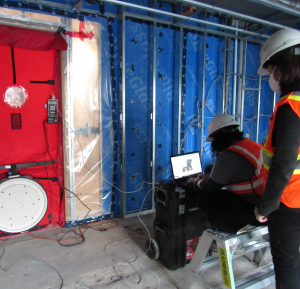Revealing Opportunities: How Energy Audits Can Improve Condo Efficiency and Reduce GHG Emissions
According to the Canadian Home Builders’ Association 2023 survey, overall energy-efficiency is number four on the list of “must haves” for Canadian Home Buyers. Beyond the financial benefits, energy efficient homes and buildings contribute to a healthier living environment.
With this in mind, and as energy and utility costs continue to increase, condominiums are looking to energy audits for a clear roadmap towards optimizing building efficiency. An energy assessment is the first step to gaining control over resources, reducing operating expenses, understanding a building’s carbon footprint, and improving indoor environmental comfort. As the environmental impact of buildings throughout Ontario comes under increasing scrutiny, the importance of completing energy audits is quickly becoming apparent.
Ontario’s Energy and Water Reporting and Benchmarking (EWRB) now requires all multi-residential buildings of 50,000 square feet and over to annually report their building’s energy and water consumption. This means responsible condominium boards and building managers are carefully analyzing their building’s utility bills and paying greater attention to how much money they are spending on utilities alone. This often raises the question: How can we save? Ontario’s unique climate of extreme hot and cold draws on utilities according to the season and requires a whole building approach to reduce energy consumption, and consequently, carbon emissions.
One of the best ways for Ontario condominiums to define that approach is the American Society of Heating, Refrigerating and Air-Conditioning Engineers (ASHRAE) Level 2 Energy Audit. This is an in-depth study, analyzing two to three years of utility usage to quantify base loads and identify seasonal variations. A level two study helps condominiums identify opportunities to improve energy performance through completion of a comprehensive visual review of all assets including HVAC, domestic hot water, plumbing, power distribution, and lighting—all of which impact a building’s energy consumption. This scope also includes the full building envelope: balconies, roof areas, windows, and cladding.
“Conducting a thorough assessment of the building to identify priority areas or systems with the highest energy consumption allows the condo board and owners to focus on upgrades that offer the greatest savings,” explains Sean Moore, Project Manager of Energy & Carbon Reduction team with Pretium Engineering. “Our experience in existing building retrofits, combined with meeting directly with property managers and occupants, allows us to understand each building’s unique needs and identify key areas nearing the end of their service life, ensuring that we develop practical, tailored solutions.”
 During an ASHRAE Level 2 Energy Audit, approximately 5-10% of all suites are inspected, including common areas to review the condition of energy consuming fixtures, equipment, envelope, balconies, doors, and windows. A complete exterior review of the site is also undertaken from grade, focusing on building cladding and energy consuming components such as exterior lighting.
During an ASHRAE Level 2 Energy Audit, approximately 5-10% of all suites are inspected, including common areas to review the condition of energy consuming fixtures, equipment, envelope, balconies, doors, and windows. A complete exterior review of the site is also undertaken from grade, focusing on building cladding and energy consuming components such as exterior lighting.
Baseline and Benchmark Performance
Energy usage data is used to create a baseline to help measure energy savings for the proposed Energy Conservation Measures (ECMs). This baseline will measure the energy savings from proposed improvements and track future energy performance. It will also be used to calculate building energy efficiency using four (4) primary metrics:
- Building Energy Performance Index (BEPI): Total energy use divided by building size.
- Total Energy Use Intensity: Total energy use converted to a standard unit, equivalent kWh (ekWh), and divided by conditioned space within the building.
- Water Use Intensity (WUI): Total litres of water converted to a standard unit and divided by condition space within the building.
- Green House Gas Intensity (GHGI): Total energy use converted using local grid factors for gas and electricity divided by condition space within the building. GHGI is expressed as the amount of Carbon Dioxide (CO₂)-equivalent emissions per square meter of floor space per year.
Unlocking Available Funding
“An ASHRAE Level Two energy audit helps the condominium board and property manager get an idea of how the building is performing. From there, we can explore the applicable retrofit/incentive programs to help further improve the return on investment,” explains Moore.
To support condominium corporations in their energy efficiency journey, a variety of incentive programs are available. Through programs like the IESO Ontario’s Save On Energy rebates and Enbridge Commercial & Multi-Residential Air Tightness Testing Program, the available financial supports can offset the costs of implementing Energy-Conservation Measures (ECM) identified in audits. During the audit, Pretium will identify funding opportunities and provide high level estimates of their value. Once an audit is complete, Pretium can assist with fulfilling the requirements for the selected rebate application(s).
 “An in-depth, full building energy audit has the potential to cut energy consumption and greenhouse gas emissions by 50-80%,” suggests Moore, who asserts that incentive programs are beginning to switch their focus: “Traditionally, incentive programs were primarily focused on reducing energy costs and usage, but we’re now seeing incentive programs focused on improving greenhouse gas emissions, accessibility and occupant comfort.”
“An in-depth, full building energy audit has the potential to cut energy consumption and greenhouse gas emissions by 50-80%,” suggests Moore, who asserts that incentive programs are beginning to switch their focus: “Traditionally, incentive programs were primarily focused on reducing energy costs and usage, but we’re now seeing incentive programs focused on improving greenhouse gas emissions, accessibility and occupant comfort.”
As the incentive programs evolve, Pretium adapts their strategies to maximize the benefits of the latest financing and rebate opportunities available for their clients. Their skilled team of in-house envelope specialists, building performance modelers, engineers, and project managers, diligently seek out emerging incentive opportunities and the latest technologies to optimize project returns.
Putting it all Together
Upon audit completion, Pretium delivers a comprehensive report detailing estimated capital, utility savings, emissions reductions, operational cost reductions, payback periods, project timing, and available incentives for each Energy Conservation Measure (ECM). This report can be used as a road map for the condominium, allowing them to execute their chosen ECMs either as components near the end of their useful service life, or as funding allows.
By investing in a thorough energy audit and leveraging available incentives, Ontario condominiums can achieve a triple bottom line: reduced energy costs, improved resident satisfaction, and a smaller environmental footprint. This strategic approach positions these buildings as leaders in sustainable development.
To learn more, visit www.pretiumengineering.com.
The post Revealing Opportunities: How Energy Audits Can Improve Condo Efficiency and Reduce GHG Emissions appeared first on REMINET.


